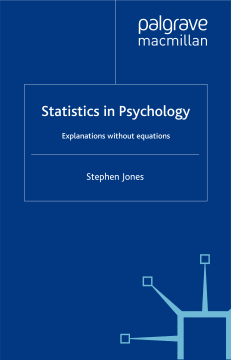
Additional Information
Book Details
Abstract
A refreshing and much-needed introduction to statistics in psychology for students who 'don't get numbers'. Jones breaks from the traditional, numerical approaches, drawing on non-numerical examples and scenarios from both psychological literature and everyday life to explain key statistical concepts. This is an ideal companion to core textbooks.
STEPHEN JONES is Senior Lecturer in the Department of Psychology at the University of the West of England, UK, where he has been teaching Experimental Psychology, Research Methods and Statistics for the past ten years. He is a Chartered Psychologist, Chartered Scientist, Associate Fellow of the British Psychological Society and a Fellow of the Higher Education Academy.
'Statistics in Psychology offers an excellent gentle introduction to the area of statistics for any student new to psychology and who may suffer from a 'fear of numbers'. This student-friendly text provides a clear explanation of the key statistical concepts without reference to mathematical formulae. A great emphasis on everyday examples and actual psychological studies makes this book an invaluable addition to any student's or lecturer's bookshelf.' - Dr Jean-Francois Delvenne, University of Leeds, UK
'An excellent and student-friendly introductory text. The use of non-numerical examples and psychologically based scenarios is a refreshing and reassuring approach to introducing a topic that many students regard with trepidation.' - Dr Judith A. Smith, University of Liverpool, UK
"friendly and accessible... a good starting point for many first-year psychology students." - George Sandamas, Department of Psychology, Middlesex University, UK
Table of Contents
| Section Title | Page | Action | Price |
|---|---|---|---|
| Cover | Cover | ||
| Contents | vii | ||
| List of illustrations | x | ||
| Preface | xiii | ||
| Acknowledgements | xvi | ||
| Chapter 1 Variables and participants | 1 | ||
| 1.1 Variables and their measurement | 3 | ||
| 1.1.1 Concepts | 3 | ||
| 1.1.2 Everyday examples | 5 | ||
| 1.1.3 From the literature | 8 | ||
| 1.1.4 Narrative | 18 | ||
| 1.1.5 Further reading | 21 | ||
| 1.2 Research design | 23 | ||
| 1.2.1 Concepts | 23 | ||
| 1.2.2 Everyday examples | 25 | ||
| 1.2.3 From the literature | 27 | ||
| 1.2.4 Narrative | 30 | ||
| 1.2.5 Further reading | 34 | ||
| 1.3 Summary | 35 | ||
| Chapter 1 self-test | 37 | ||
| Chapter 2 Descriptive statistics | 39 | ||
| 2.1 Summarizing findings via measures of central tendency | 41 | ||
| 2.1.1 Concepts (Mode, Median and Mean) | 41 | ||
| 2.1.2 Everyday examples | 43 | ||
| 2.1.3 From the literature | 47 | ||
| 2.1.4 Narrative | 50 | ||
| 2.1.5 Further reading | 51 | ||
| 2.2 Summarizing findings via measures of dispersion | 52 | ||
| 2.2.1 Concepts (Range and Interquartile range, Variance, Standard deviation) | 52 | ||
| 2.2.2 Everyday examples | 54 | ||
| 2.2.3 From the literature | 56 | ||
| 2.2.4 Narrative | 59 | ||
| 2.2.5 Further reading | 61 | ||
| 2.3 Summarizing findings via percentiles and standard scores | 62 | ||
| 2.3.1 Concepts (Percentiles and Z-scores) | 62 | ||
| 2.3.2 Everyday examples | 63 | ||
| 2.3.3 From the literature | 67 | ||
| 2.3.4 Narrative | 69 | ||
| 2.3.5 Further reading | 71 | ||
| 2.4 Summary | 72 | ||
| Chapter 2 self-test | 74 | ||
| Chapter 3 Prelude to testing | 76 | ||
| 3.1 Populations, samples and standard errors | 78 | ||
| 3.1.1 Concepts | 78 | ||
| 3.1.2 Examples and illustrations | 81 | ||
| 3.1.3 Further reading | 84 | ||
| 3.2 Hypothesis testing, probability and the statistical significance | 85 | ||
| 3.2.1 Concepts | 85 | ||
| 3.2.2 Examples and illustrations | 87 | ||
| 3.2.3 Further reading | 91 | ||
| 3.3 Parametric assumptions | 92 | ||
| 3.3.1 Concepts | 92 | ||
| 3.3.2 Examples and illustrations | 95 | ||
| 3.3.3 Further reading | 99 | ||
| 3.3.4 Narrative | 100 | ||
| 3.5 Summary | 103 | ||
| Chapter 3 self-test | 105 | ||
| Chapter 4 Inferential statistics | 107 | ||
| 4.1 Parametric testing | 110 | ||
| 4.1.1 Concepts (Difference between, Difference within, Correlation) | 110 | ||
| 4.1.2 Everyday examples | 112 | ||
| 4.1.3 From the literature | 120 | ||
| 4.1.4 Narrative | 135 | ||
| 4.1.5 Further reading | 141 | ||
| 4.2 Non-parametric testing (ordinal) | 142 | ||
| 4.2.1 Concepts (Difference between, Difference within, Correlation) | 142 | ||
| 4.2.2 Everyday examples | 144 | ||
| 4.2.3 From the literature | 150 | ||
| 4.2.4 Narrative | 165 | ||
| 4.2.5 Further reading | 170 | ||
| 4.3 Non-parametric testing (nominal) | 171 | ||
| 4.3.1 Concepts (Difference between, Difference within) | 171 | ||
| 4.3.2 Everyday examples | 172 | ||
| 4.3.3 From the literature | 177 | ||
| 4.3.4 Narrative | 190 | ||
| 4.3.5 Further reading | 193 | ||
| 4.4 Summary | 194 | ||
| Chapter 4 self-test | 195 | ||
| And finally… | 198 | ||
| Appendix | 200 | ||
| Glossary | 202 | ||
| References | 210 | ||
| Answers to self-tests | 215 | ||
| Index | 219 |
